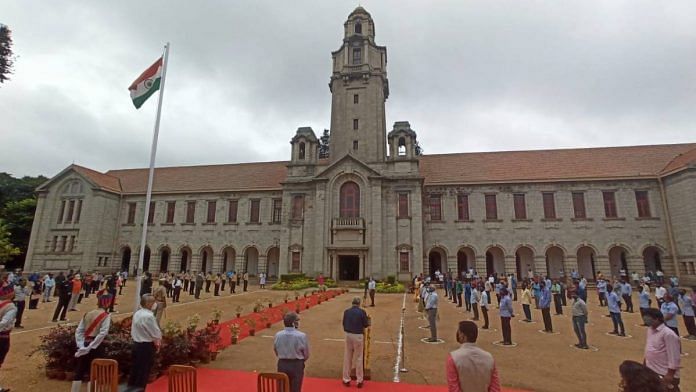New Delhi: Four years after being arrested from Agartala for his alleged involvement in a 2005 terrorist attack at the Indian Institute of Science in Bengaluru, 40-year-old Habeeb Miya was released last week.
On 14 June, a National Investigation Agency (NIA) special court opined that there wasn’t sufficient ground to proceed against him in the case.
NIA Special Court judge Dr Kasanappa Naik also said that he “failed to understand, as to why this accused No.7 was arraigned as accused in the case”, asserting that there was no evidence to show that he had any knowledge about the attack.
According to the judgment, “There is no independent evidence available to prove that accused No.7 (Miya) assisted accused No.1 to do any criminal and unlawful acts”.
On 28 December 2005, two armed persons entered the IISc campus in Bengaluru around 7 pm in a white Ambassador car while delegates of an international conference were heading for dinner. The two gunmen started firing indiscriminately and killed Professor M.C. Puri of IIT Delhi while four other academics were injured.
Miya was accused of helping a key accused, Sabahuddin Ahmed, cross over to Bangladesh, both before and after the attack.
However, the court asserted that if at all Miya did help Ahmed cross the border illegally, “it is for the concerned police at Tripura to prosecute him in this regard and he cannot be prosecuted in this case”.
Also read: 26/11-like terror strike almost impossible now, says Defence Minister Rajnath Singh
Miya arrested 12 years after attack
The first break in the case was made three years after the attack, with the arrest of Sabahuddin from Nepal in early 2008. Sabahuddin allegedly harboured Abu Hamza, the attacker, in a room near his college in Bengaluru. Hamza purportedly escaped to Pakistan, and his whereabouts and fate remain unclear.
Miya was arrested 12 years after the incident, in 2017, and was accused under sections 120B (criminal conspiracy), 121 (waging or attempting to wage war of abetting waging of war against Government of India), 121A (conspiracy to commit offences under section 121), 122 (collecting arms etc with intention of waging war), 123 (concealing with intent to facilitate design to wage war), 307 (attempt to murder) and 302 (murder) of the Indian Penal Code, along with provisions of the Indian Arms Act, Explosive Substances Act and Unlawful Activities (Prevention) Act.
After his arrest, Miya submitted before the court that the police had not said anything against him in the chargesheet and had also not collected any evidence that showed his knowledge or involvement in the crime.
He was made an accused in the case on the basis of a disclosure statement made by Sabahuddin, who is a key accused in the case. Sabahuddin had recorded his statement in March 2008 and told authorities that he went to Tripura in May 2005 and met Miya.
The prosecution alleged that Miya helped Sabahuddin cross the border illegally to Bangladesh, where the latter met Pakistani terrorists. Miya also allegedly helped Sabahuddin come back to India, after which the IISc terror attack was carried out.
Miya was further accused of helping Sabahuddin escape to Bangladesh after the attack.
“…thus, as per the prosecution, this accused No.7 (Miya) though having knowledge that he is involved in the shootout case in IISc., in Bengaluru and he too have Jihadi mindset and thus, even this accused No.7 is also involved in the crime,” the order noted.
Miya, however, contended that the disclosure statement did not imply that he had any knowledge that Sabahuddin would commit terrorist activities in Bengaluru. His lawyer called the disclosure statement “totally baseless and inadmissible in evidence”.
Also read: NIA court clears Akhil Gogoi of charges under UAPA in one anti-CAA protests case
‘Rs 100 to cross the India-Bangladesh border’
According to Sabahuddin’s statement to the investigating officer, he was asked by a man named Abdul Aziz to travel to Bangladesh to finalise the details of a terror attack in Bengaluru.
When he wasn’t able to do so from Kolkata, Sabahuddin visited a book shop to buy a map and then realised that Agartala is the nearest city to the Bangladesh border.
He then took a flight to Agartala and visited the Gedu Mian Mosque “where Tablighi Jamaat were being preached to the people in Tripuri language”, the order noted.
This is where he claimed to have met Miya and sought his help in travelling to Bangladesh to meet Aziz.
Miya then allegedly told Sabahuddin that his maternal family stays in Cumilla City in Bangladesh and that he visits Bangladesh by crossing the border without a passport. And a trip to the country was arranged.
The statement said that the duo went to the border by a three-wheeler, paid Rs 100 to the security forces at the border with the help of Miya’s uncle, and crossed the Akhaura border.
Sabahuddin then met Aziz in Dhaka and was reportedly escorted back to Agartala by Miya.
‘No evidence to show criminal intention’
The court, however, now considered Sabahuddin disclosure statement in detail and opined that “except these averments, there is nothing to indicate that accused No.7 had knowledge that accused No.1 is terrorist or he is receiving funds from terrorists, and he has planned to commit terrorist acts in Bengaluru”.
It asserted that Sabahuddin’s statement disclosed that he had neither revealed his real name to Miya nor had he told him why he was going to Bangladesh.
“It is seen that thereafter, accused No.7 was arrested and his statement was also recorded and thereafter, there is no further evidence collected to prove the involvement of accused No.7 in the crime…There is absolutely no legal evidence to show that accused No.7 had criminal intention or done any criminal acts,” the court said.
(Edited by Rachel John)
Also read: IISc world’s top research university in QS World Rankings, is 1st Indian varsity to score a 100






